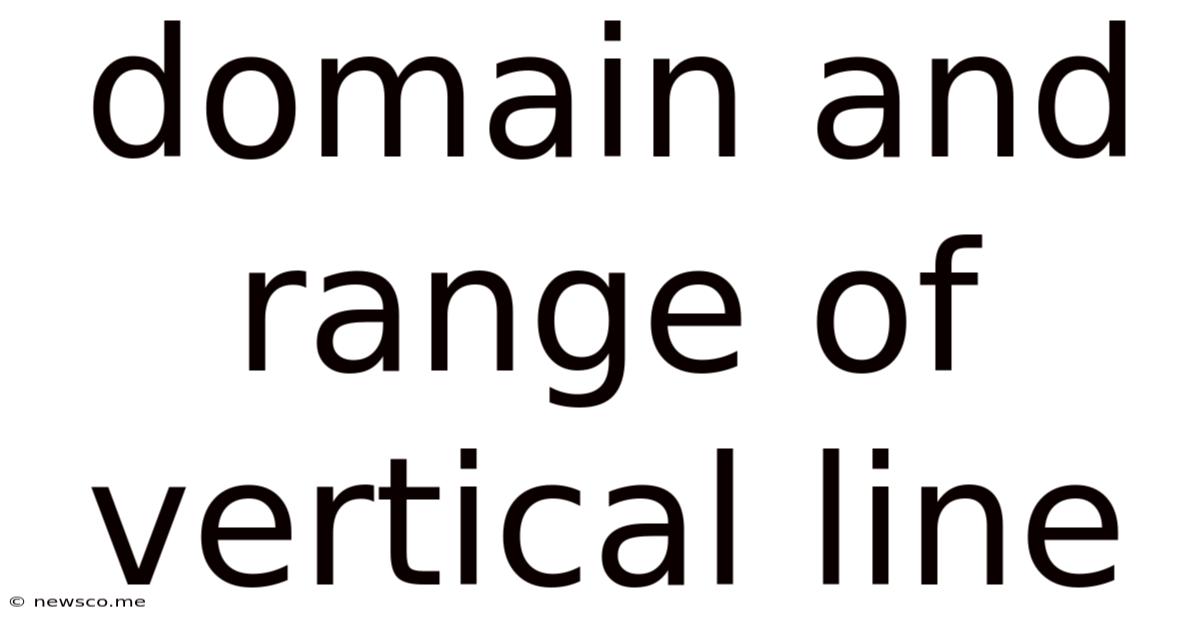Domain And Range Of Vertical Line
News Co
May 08, 2025 · 4 min read

Table of Contents
Domain and Range of a Vertical Line: A Comprehensive Guide
Understanding the domain and range of functions is fundamental in mathematics, particularly when dealing with graphical representations. While many functions have readily apparent domains and ranges, the vertical line presents a unique case that often causes confusion. This comprehensive guide will delve into the intricacies of determining the domain and range of a vertical line, clarifying common misconceptions and providing a solid foundation for further mathematical exploration.
What are Domain and Range?
Before we tackle the specifics of vertical lines, let's establish a clear understanding of domain and range.
-
Domain: The domain of a function refers to the set of all possible input values (often denoted as 'x') for which the function is defined. Think of it as the set of all x-values that produce a valid y-value. In simpler terms, it's what you can put into the function.
-
Range: The range of a function is the set of all possible output values (often denoted as 'y') that the function can produce. It's the set of all y-values that result from applying the function to the values in its domain. In simpler terms, it's what you get out of the function.
The Unique Case of the Vertical Line
A vertical line is represented by the equation x = k, where 'k' is a constant. Unlike other functions where each input 'x' maps to a unique output 'y', a vertical line has only one x-value for infinitely many y-values. This characteristic significantly impacts its domain and range.
Visualizing the Vertical Line
Imagine a vertical line on a Cartesian plane. Notice how it extends infinitely upwards and downwards, intersecting the x-axis at a single point, 'k'. This visual representation helps clarify the concept of domain and range.
Determining the Domain of a Vertical Line
Since a vertical line only exists at a single x-coordinate, 'k', its domain is restricted to that single value. Therefore, the domain of a vertical line x = k is:
Domain: {k}
This means the only acceptable input for the equation x = k is 'k' itself. Any other value of x would not lie on the line.
Determining the Range of a Vertical Line
The vertical line extends infinitely in both positive and negative y-directions. This means there's no limit to the possible y-values. Consequently, the range of a vertical line is all real numbers. This can be expressed as:
Range: (-∞, ∞) or Range: ℝ
This notation signifies that the range encompasses every possible real number.
Why is a Vertical Line Not a Function?
A crucial point to remember is that a vertical line does not represent a function. The definition of a function mandates that each input (x-value) corresponds to only one output (y-value). Since a vertical line has countless y-values associated with a single x-value, it violates this fundamental rule, hence it's not a function.
Common Misconceptions
Several misunderstandings frequently arise when discussing the domain and range of a vertical line:
-
Confusing Domain and Range: Many learners confuse the domain and range, mistakenly assigning the single x-value to the range and the infinite y-values to the domain. Remembering the definitions – input (x) for domain and output (y) for range – helps prevent this.
-
Assuming a Limited Range: Some incorrectly assume the vertical line has a limited range because it might appear to terminate on the screen or within a particular graph. It is vital to understand that the line extends infinitely, implying an unbounded range.
Practical Applications and Further Exploration
While a vertical line itself isn't a function, understanding its domain and range is crucial for various mathematical concepts:
-
Piecewise Functions: Vertical lines can form boundaries in piecewise functions, defining intervals where different functions apply.
-
Limits and Continuity: Analyzing the behavior of functions as they approach vertical lines is essential in calculus when exploring concepts like limits and continuity.
-
Graphing and Visualizing Data: Understanding domain and range is critical for accurately interpreting graphs and visualizations. Identifying the domain and range of various components in a graph, including vertical lines, is essential for comprehending the full picture of the data being represented.
-
Linear Equations: While vertical lines are not functions, the concept of domain and range lays the groundwork for understanding the behavior of linear equations and their graphical representations in various contexts. Understanding these foundational concepts enables a deeper understanding of more complex mathematical relationships.
Conclusion: Mastering the Domain and Range of a Vertical Line
The domain and range of a vertical line, while seemingly simple, can pose a challenge due to its unique characteristics. By clearly understanding the definitions of domain and range and applying them correctly, one can accurately determine the domain ({k}) and range ((-∞, ∞) or ℝ) of a vertical line represented by x = k. Furthermore, recognizing that a vertical line is not a function is crucial. This understanding forms a vital building block for navigating more complex mathematical concepts and accurately interpreting graphical representations in various applications. This comprehensive exploration of the domain and range of vertical lines should serve as a valuable resource, clarifying common misconceptions and strengthening mathematical understanding. Continued practice and exploration will solidify this knowledge, enabling you to approach similar problems with confidence and accuracy.
Latest Posts
Related Post
Thank you for visiting our website which covers about Domain And Range Of Vertical Line . We hope the information provided has been useful to you. Feel free to contact us if you have any questions or need further assistance. See you next time and don't miss to bookmark.